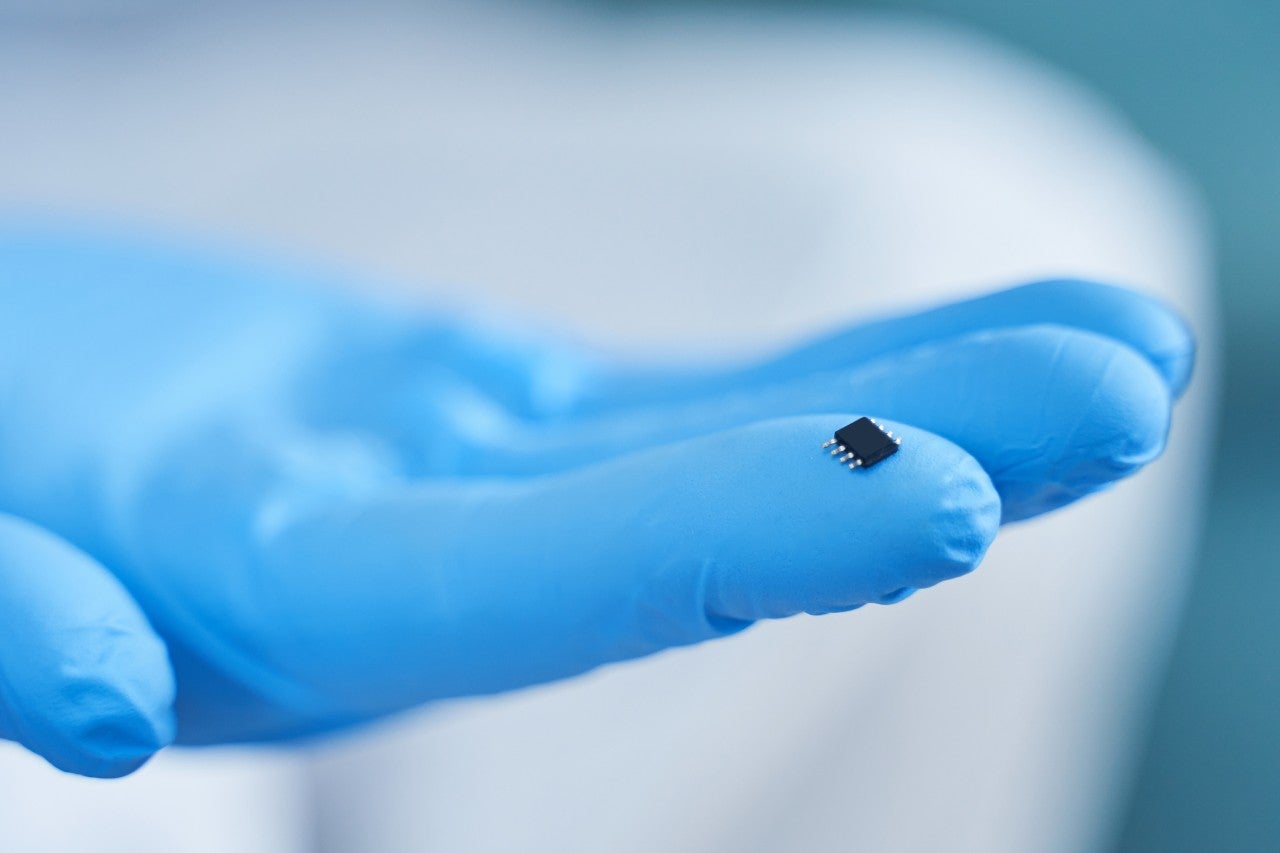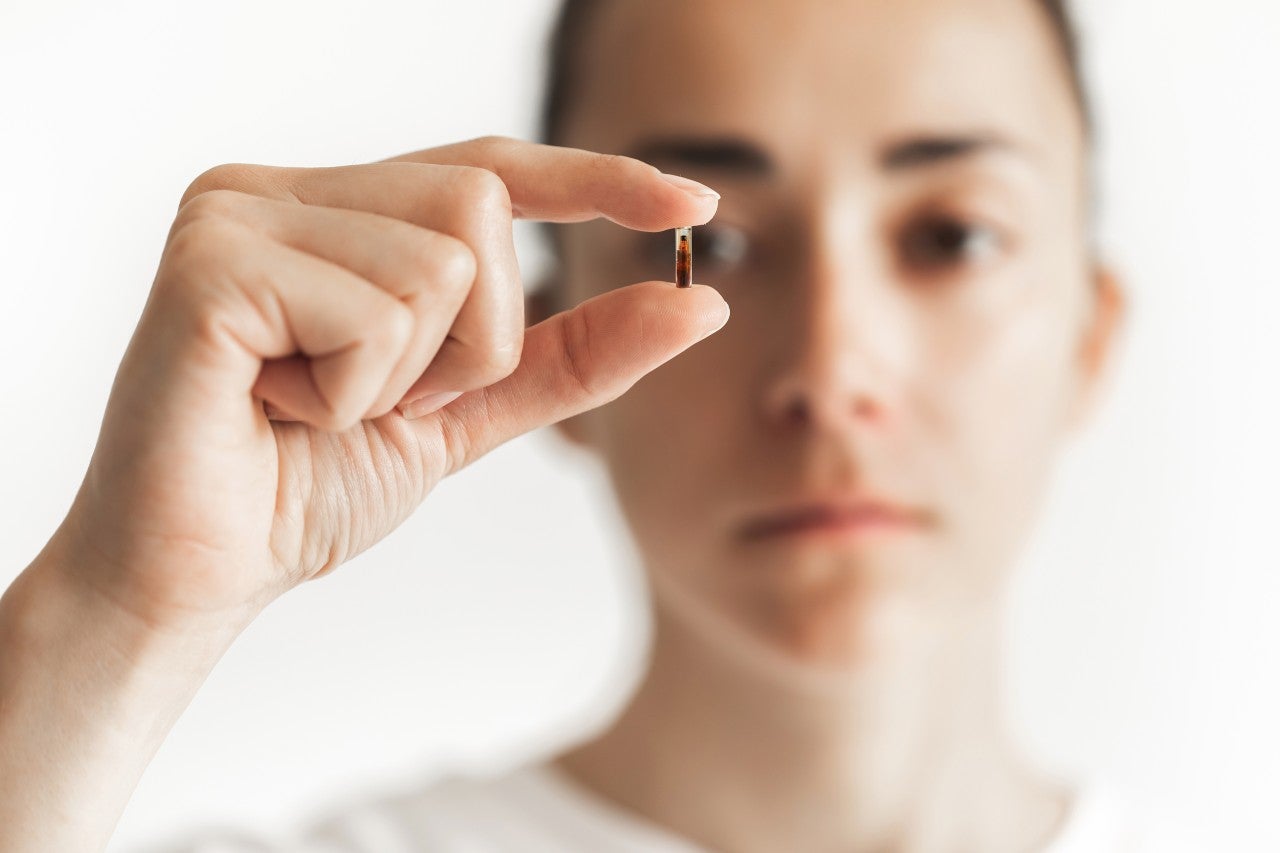
It’s best not to advertise this to vaccine refusers, but microchips are being injected into people – in clinical trials, at least. They’ve been touted for their ability to constantly monitor patient vitals, allowing for more reactive treatment, as well as better monitoring of long-term conditions. Mae Losasso assesses the potential of implants with Daniel Andersson, associate professor in physiology at Karolinska University Hospital in Sweden, who recently ran a study into using chips for temperature monitoring; and Chen Shi of Columbia University, designer of a chip no larger than a mote of dust.
“It seems like something that belongs to the future,” says Daniel Andersson, associate professor in physiology at Karolinska University Hospital in Sweden. He’s talking about tiny, injectable chips – about the size of two grains of rice – that can be implanted under the skin to measure body temperature.
Developed by Swedish start-up DSruptive Subdermals, these microchips look like capsules and are made from biocompatible glass, with an electronic inlay that has an NFC antenna and a temperature sensor.
Sitting a few millimetres under the skin, between the upper dermis and the subcutaneous fat, all one of these chips requires to function is a smartphone: simply hover it over the skin and a temperature measurement can be taken.
This really is the stuff of the future. But implantables, Andersson stresses, are nothing new. “The concept of [implantable] devices is pretty common in cardiology,” he says. “Pacemakers have been around since the end of the 1950s or so.” What sets the DSruptive Subdermals chip apart from its implantable precursors is, in a word, size.
Powered by an electromagnetic circuit, which feeds on the communication platforms found in smartphones, these little chips don’t need a battery or wires, which means they require only minimally invasive injection and removal procedures. Once they’re in, you hardly notice them at all. Unlike wearable devices – smartwatches or fitness trackers – these discreet little implants can’t be lost, are hard to break, and provide, as tests have shown, more reliable data.
After the chips were inserted into 36 trial participants – in either the arm, the pectoral, or the lower abdomen – the first task was to determine whether they worked. “Can you read off [the device] using the phone? Can you get temperature values from it?” Andersson recalls asking. “Yes,” he confirms, “the capsule is fully feasible.” In this initial phase, Andersson also measured how participants responded to the implants, asking “is it comfortable enough”? There too, the conclusion is yes.
“It’s not difficult to inject these small devices under the skin and it doesn’t really cause any pain or discomfort,” he says. “[Trial participants] graded [pain] on a scale from one to ten – where ten is the most severe discomfort you can imagine, and one is the lightest – and they scored it around two.”
Having determined that the technology worked – both technically and physically – the second aim of the trial was to measure the variability of the device. Andersson took three temperature measurements from a single device and scored them against the variability of the results of three measurements from conventional oral and ear methods.
“When we compared the variability among the three,” he explains, “it was not statistically different from the variability of the oral and the ear. So that’s really encouraging. There’s nothing in the device that sets off the temperature or anything that makes it uncertain in its reading.”
And that’s where Andersson’s involvement in the trial ended. As of yet, he explains, “the longitudinal tests have not been performed with this device”, so it will still be some time before we see injectable chips with a temperature measuring facility on the market.
A tinier chip for the application of implants
DSruptive Subdermals’ implants are just one technology among many currently at the development stage. One recent research project at Columbia University led to the successful development of the world’s tiniest injectable chip, designed by PhD student Chen Shi.
“The device starts with an ultra-small and ultra-low-power temperature sensor integrated circuit chip, and I also managed to build a microscale piezoelectric material directly on top of the chip’s surface through customised microfabrication approaches,” explains Chen.
“I also applied a thin layer of biocompatible material to package the device to ensure its endurability and biocompatibility for implantable applications. So, basically, through this monolithic integration – of the sensor chip, and the piece of piezoelectric material – I was able to achieve an extremely small size of only 0.065mm2, which is the size of a dust mite.”
Whereas the DSruptive Subdermals chip is powered by a smartphone, Chen’s dust-size microchip relies on ultrasound energy. “The device is wirelessly powered by ultrasound,” he explains, “and also transmits sensor data through ultrasound.” That means the device, as astoundingly futuristic as it might be, works with conventional medical imaging technology.
The chip designed by Chen hasn’t reached the clinical trial stage yet, so it’s too early to say exactly how it will perform in vivo, but experiments on mice have returned favourable results.
“For demonstration, we implant the devices in the limbs of mice and perform two sets of experiments,” Chen says. “One is to monitor the core body temperature, to show that the device can accurately acquire the body temperature of an animal; [the other is] to run modulation experiments with ultrasound [to] research the temperature behaviour of the activation site.”
In both sets of experiments, the chips are performing well and Chen is hopeful for the future of his device. “I do see large potentials for this technology,” he says. “I envision that we can actually leverage this technology to develop very tiny, wireless injectables that can be delivered into living bodies to perform real-time monitoring of all the essential, physiological signals to assess diagnostic and therapeutic applications.”

Next step for implant development
Are there any obstacles facing the development, production or use of these tiny chips? There are teething problems, Chen admits – such as stabilising the orientation of the device once implanted, or learning how to efficiently harvest ultrasound energy and transmit data at sufficiently deep implantation sites – and there are questions that still need to be answered, particularly in terms of physical impact and longevity. But such issues are to be expected in these early stages, and the initial findings look promising.
What’s more, though still at the experimental stage, both Andersson and Chen agree that once the chips have been mass produced, they’re unlikely to be too costly. This means when they do hit the markets, we should begin to see them with a degree of familiarity. But will they become widespread in healthcare? “It’s very difficult to say,” Andersson admits, “but I think we definitely will see a lot more of this.”
The real question it seems, for both Chen and Andersson, isn’t if the technology can work – the trials so far suggest, that it does – but how best to harness it. “If we can find good applications,” Andersson notes, “where we can show this is actually better than using ear thermometers for home monitoring, for instance, then we could really argue that this is an important tool for clinical consultations from home.”
The question we should be asking, he adds, is how can we use these devices “in combination with other implants and wearables” in order to gather more information about the state of a patient?
Chen’s next step is to explore the possible medical applications of his device. “For temperature, we are just trying to do a proof of concept of this technology and this platform,” he explains.
“But we want to extend it to other physiological signals as well, such as pH, blood pressure, blood glucose, blood oxygen, etcetera. We can modify this tiny device to achieve small-scale physiological monitoring. We are not only constrained to temperature: this is just the first version.”
If it seems like something that belongs to the future, that’s probably because it is; though, not in the way we might expect. Traditionally, technology emerges out of a need, but, in the case of these tiny chips, it seems that application must follow design: we have the means, but what exactly are the uses? That much remains to be seen, but one thing is for certain: there’s a world of potential in a grain of sand – or something the size of one.
This article first appeared in Medical Device Developments Vol. 1 2021. The full publication can be viewed online here.






